Next project. What to do with the high quality drivers one already owns. Left overs from projects that changed or never was.

Drivers are:
2 x Beyma TPL-150/B: https://www.beyma.com/speakers/Fichas_Tecnicas/beyma-speakers-data-sheet-amt-TPL150B.pdf
4 x Jantzen JA-8008 HMQ: https://jantzen-audio.com/wp-content/uploads/060-0008-1.pdf
2 x Beyma 18PWB1000Fe/S: https://www.beyma.com/speakers/Fich...data-sheet-low-mid-frequency-18PWB1000FeS.pdf
Since I already have Infinite Baffle subs in both my home theater (2 x 18") and my 2 channel setup (4 x 21") in the living room, why not also have it in the upstairs office?
Also, I've always been curious in finding out more about Open Baffle. All the superlatives I read about OB seem to fit my ideas of how music could sound in a room.
The idea:
Room is W3,1 x D4,6 x H2,4 m (ab. 10 x 15 x 8 ft) with slanted ceilings in the width direction. Wall height below is 1,2 m (4 ft).
Put the 18's in thick panels, one left & one right, and attach them to the studs (cc 0,6 m (2 ft)) on the 1,2 m wall. Wall panels are too flimsy to be used as is.
There's a space behind the wall that is big enough for the IB to work. Use them up to 100 Hz.
Build smallish (?) baffles for the 8" and AMT's in a D'Appolito and hang them from the ceiling about 1,5 m (5 ft) in front of the wall where the 18's are mounted.
Open the AMT's back and play dipole. X-over 1500 - 1800 Hz.
Use a MiniDSP Flex8 to do the crossovers, DSP and Dirac. (Already have this also)
Buy some class D amps to power each channel.
Maybe IcePower: https://www.soundimports.eu/en/icep...OlLo3S6XKRe-XzumApw7YwO4ijBXg34UaAkgAEALw_wcB
With power supply: https://www.soundimports.eu/en/icep...OlLo3S6XKRe-XzumApw7YwO4ijBXg34UaAkgAEALw_wcB
Maybe a Wiim as source to play music from Tidal: https://www.wiimhome.com/wiimultra/overview
Questions:
- Is my small room suitable for this idea?
- What width should the baffle be to be able to get output down towards 100 Hz from the 8's?
- Do I maybe have to buy some bigger drivers also to help the 8's to get down to 100 Hz, in a WMTMW?
- If I raise X-over to 150 hz, maybe that will help? Or is that too high for the IB?
These are my thoughts so far and now I would like to hear from you, the people with much more experience in OB. I'm a noob.
Is this idea at all feasible?
Drivers are:
2 x Beyma TPL-150/B: https://www.beyma.com/speakers/Fichas_Tecnicas/beyma-speakers-data-sheet-amt-TPL150B.pdf
4 x Jantzen JA-8008 HMQ: https://jantzen-audio.com/wp-content/uploads/060-0008-1.pdf
2 x Beyma 18PWB1000Fe/S: https://www.beyma.com/speakers/Fich...data-sheet-low-mid-frequency-18PWB1000FeS.pdf
Since I already have Infinite Baffle subs in both my home theater (2 x 18") and my 2 channel setup (4 x 21") in the living room, why not also have it in the upstairs office?
Also, I've always been curious in finding out more about Open Baffle. All the superlatives I read about OB seem to fit my ideas of how music could sound in a room.
The idea:
Room is W3,1 x D4,6 x H2,4 m (ab. 10 x 15 x 8 ft) with slanted ceilings in the width direction. Wall height below is 1,2 m (4 ft).
Put the 18's in thick panels, one left & one right, and attach them to the studs (cc 0,6 m (2 ft)) on the 1,2 m wall. Wall panels are too flimsy to be used as is.
There's a space behind the wall that is big enough for the IB to work. Use them up to 100 Hz.
Build smallish (?) baffles for the 8" and AMT's in a D'Appolito and hang them from the ceiling about 1,5 m (5 ft) in front of the wall where the 18's are mounted.
Open the AMT's back and play dipole. X-over 1500 - 1800 Hz.
Use a MiniDSP Flex8 to do the crossovers, DSP and Dirac. (Already have this also)
Buy some class D amps to power each channel.
Maybe IcePower: https://www.soundimports.eu/en/icep...OlLo3S6XKRe-XzumApw7YwO4ijBXg34UaAkgAEALw_wcB
With power supply: https://www.soundimports.eu/en/icep...OlLo3S6XKRe-XzumApw7YwO4ijBXg34UaAkgAEALw_wcB
Maybe a Wiim as source to play music from Tidal: https://www.wiimhome.com/wiimultra/overview
Questions:
- Is my small room suitable for this idea?
- What width should the baffle be to be able to get output down towards 100 Hz from the 8's?
- Do I maybe have to buy some bigger drivers also to help the 8's to get down to 100 Hz, in a WMTMW?
- If I raise X-over to 150 hz, maybe that will help? Or is that too high for the IB?
These are my thoughts so far and now I would like to hear from you, the people with much more experience in OB. I'm a noob.
Is this idea at all feasible?
Here's what inspired me:
https://hifi.nl/artikel/30318/Revie...akers-turning-disadvantage-into-progress.html



https://hifi.nl/artikel/30318/Revie...akers-turning-disadvantage-into-progress.html
@ZACC
this looks all so good you will certainly get something done with it!
I like more simple designs striving for good time behaviour, too. A domain of fullrange speakers.
So 15 inch fullrange up to 4khz and simple filtered piezo aligned and EQed for free on a smartfone.
this looks all so good you will certainly get something done with it!
I like more simple designs striving for good time behaviour, too. A domain of fullrange speakers.
So 15 inch fullrange up to 4khz and simple filtered piezo aligned and EQed for free on a smartfone.
finished loudspeaker and some easy EQ makes it tonally correct.
As it is a fullrange going up to 4khz the piezo tunes in perfectly.
Its pretty high end with applied EQ.
Unequalized EQ response in red
As it is a fullrange going up to 4khz the piezo tunes in perfectly.
Its pretty high end with applied EQ.
Unequalized EQ response in red
I'd advice you to take some time and dig around on the forum for info there is a lot of it, for example the TPL, use, driver matching and modifications.Open the AMT's back and play dipole. X-over 1500 - 1800 Hz.
It has a objectionable resonance @1,6khz.
So it will perform it's best with a XO, in the 1,9k and up range, else you might want to look at modifications to it.
The 8" is likely a better match in the 1,5-1.8k region.
It is also the limiting factor in this setup with it's 3mm xmax, wanting to use it to 100hz.
Else choosing a 8" mtm with a high xo frequency, along with a very large AMT, means you have a high CTC distance and fairly pronounced lobing.
If the driver behaves well, and it is close enough to the 8" mtm center, it should be okay.If I raise X-over to 150 hz, maybe that will help? Or is that too high for the IB?
DIstance and XO freq. decides mostly. The high up the easier localization is.
Last edited:
Anybody care to share answers to these questions?
- What width should the baffle be to be able to get output down towards 100 Hz from the 8's?
- Do I maybe have to buy some bigger drivers also to help the 8's to get down to 100 Hz, in a WMTMW?
- What width should the baffle be to be able to get output down towards 100 Hz from the 8's?
- Do I maybe have to buy some bigger drivers also to help the 8's to get down to 100 Hz, in a WMTMW?
It's not that simple.... how much spl do you need?
A simple but demonstrative baffle effect simulator https://www.tolvan.com/index.php?page=/edge/edge.php
Dsp helps a lot to match spl and on-axis response, but getting reasonably good dispersion depends more on the baffle size and shape.
It is a mystery to me how IB and OB will work together... Be ready to use delay for OB signal. And OB distance fom wall/IB creates comb filtering in upper bass-midrange, rotate dipoles inwards to reduce this effect. Late reflections from backside radiation create the "dipole sound"
Basics: https://musicanddesign.speakerdesign.net/tech.html
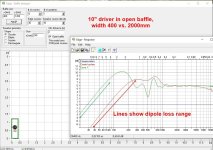
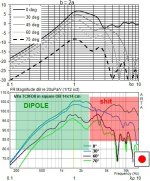
ps. buy also 4-5" midranges and make speakers 4-way!

A simple but demonstrative baffle effect simulator https://www.tolvan.com/index.php?page=/edge/edge.php
Dsp helps a lot to match spl and on-axis response, but getting reasonably good dispersion depends more on the baffle size and shape.
It is a mystery to me how IB and OB will work together... Be ready to use delay for OB signal. And OB distance fom wall/IB creates comb filtering in upper bass-midrange, rotate dipoles inwards to reduce this effect. Late reflections from backside radiation create the "dipole sound"
Basics: https://musicanddesign.speakerdesign.net/tech.html


ps. buy also 4-5" midranges and make speakers 4-way!
Last edited:
It'll depend just how much output you want, but I'd guess that you could do 100 Hz. Below is a sim in Basta! of a pair of the Jantzen 8 inch drivers on a 300mm by 700mm open baffle. I've set input level as 17 volts, and applied a 1st order active high-pass filter at 100 Hz. (I've also applied a passive network to equalise baffle step - 3mH in parallel with 8 ohms). The -6dB point is about 105 Hz.
This won't be a good guide to the midrange response, but it should be a decent predictor of LF roll-off, and maximum output capability. As you can see, at 17V input you are reaching max output; excursion below the LF crossover is where you reach the limit first. In the passband, you are getting close to 110 dB at 1m. This is plausible to me - after all the Linkwitz LX521 used a single 8" driver with 4mm of linear excursion on a small baffle down to something like 100-120 Hz.

PS. Incase it's not obvious, black is SPL, grey is max SPL, red is excursion, green is impedance. Simulation takes account of TS paraments, baffle shape/size, and active/passive filters applied.
This won't be a good guide to the midrange response, but it should be a decent predictor of LF roll-off, and maximum output capability. As you can see, at 17V input you are reaching max output; excursion below the LF crossover is where you reach the limit first. In the passband, you are getting close to 110 dB at 1m. This is plausible to me - after all the Linkwitz LX521 used a single 8" driver with 4mm of linear excursion on a small baffle down to something like 100-120 Hz.
PS. Incase it's not obvious, black is SPL, grey is max SPL, red is excursion, green is impedance. Simulation takes account of TS paraments, baffle shape/size, and active/passive filters applied.
Last edited:
Please elaborate. Why?ps. buy also 4-5" midranges and make speakers 4-way!
That would make sense.Hourglass?
It occurs to me that another option for the bass would be to use the Beyma 18 on an open baffle (or H baffle). If they are playing along the 4.6m length you might be able to squeeze that in. If they are against the wall at one side that could work (and boost LF extension/efficiency), so long as they are crossing low, say 100-120Hz.. The Beyma has plenty of excursion, enough to get you down to 35-40 Hz at a decent level. If you can live with this in your office, it would avoid the complications of combining OB and IB.
Last edited:
The thought has crossed my mind...
I'm a bit worried that an OB 18" won't do much when it comes to bass. I know what an IB can do. 🙂
Also I'm a nood on OB so I have no idea what to expect in my small room. Maybe it's worth a try. Any suggestions on H baffle size?
If I have the 8's directly above the H baffle, maybe I can cross higher and reduce baffle width on the 8's?
I'm a bit worried that an OB 18" won't do much when it comes to bass. I know what an IB can do. 🙂
Also I'm a nood on OB so I have no idea what to expect in my small room. Maybe it's worth a try. Any suggestions on H baffle size?
If I have the 8's directly above the H baffle, maybe I can cross higher and reduce baffle width on the 8's?
Please study the stories behind Linkwitz LX521.4 and Kreskovsky's NaO Note II. Drivers for low end in OB require lots of EQ and Xmax capacity - and you have it! You should have no problems above 30Hz in normal size room and below 110dB. I would not abandon IB totally, you might want subsonics for eg. movies. What you don't have is smallish mids for freqs 1-5kHz. Doubling upper mids is not necessary to keep distortion low. The smaller the baffle is the higher in frequency dipole radiation pattern happens. Practical upper limit is around 6kHz, because of driver's minimal dimensions. Beyma TPL with waveguide is often used with dipoles, preferably without the backplate/enclosure https://www.diyaudio.com/community/threads/my-open-baffle-dipole-with-beyma-tpl-150.142015/
https://www.linkwitzlab.com/LX521/LX521_4.htm
https://musicanddesign.speakerdesign.net/NaO_Note_II_RS.html
Dipoles operating in dipole radiation pattern don't have edge interferences or box resonances. They radiate in 8-pattern, as loud backwards and towards the listener (direct sound). Aiming the rearside sound indirecttly to be reflected to the listener by 2 reflections is important to make them work well and have "spaciousness" without loosing good stereo imaging. In a too small or too damped room the are just waste of resources.
Here is also very good info in German by Rudolf Finke http://www.dipolplus.de/
My 4-way dipoles use monopole woofer below 150Hz, single 10" per speaker. 12" low mid, planars for upper mid and tweeter.
https://drive.google.com/file/d/1a44vFKWPlnALozIWkUXtBFl90Haa35JE/view?usp=sharing
https://www.linkwitzlab.com/LX521/LX521_4.htm
https://musicanddesign.speakerdesign.net/NaO_Note_II_RS.html
Dipoles operating in dipole radiation pattern don't have edge interferences or box resonances. They radiate in 8-pattern, as loud backwards and towards the listener (direct sound). Aiming the rearside sound indirecttly to be reflected to the listener by 2 reflections is important to make them work well and have "spaciousness" without loosing good stereo imaging. In a too small or too damped room the are just waste of resources.
Here is also very good info in German by Rudolf Finke http://www.dipolplus.de/
My 4-way dipoles use monopole woofer below 150Hz, single 10" per speaker. 12" low mid, planars for upper mid and tweeter.
Ok folks, inspired by the discussions of room acoustics, sound perception and boundary reflections here at diyaudio.com, I hereby start a new thread for a collaboratory speaker project named
Aino gradient
The inspiration to this project is the legendary and revolutionary home stereo speaker by designer Jorma Salmi, the Gradient 1.0 and it's siblings.
History
We will discuss it's design principles and we try to reconstruct and perhaps even go beyond it's performance and sound quality in contemporary domestic room environment.
This is not a commercial project and if we...
Aino gradient
The inspiration to this project is the legendary and revolutionary home stereo speaker by designer Jorma Salmi, the Gradient 1.0 and it's siblings.
History
We will discuss it's design principles and we try to reconstruct and perhaps even go beyond it's performance and sound quality in contemporary domestic room environment.
This is not a commercial project and if we...
Last edited:
Since you're going to use DSP, response can be whatever you want it to be. But With OB, you'll run out of displacement pretty quickly if you try to go too low. OB will never complete with IB for the very low end. Linkwitz used 2 x 10" (with 12.5mm xmax) in a compact H baffle (300mm by 300mm by 600mm approx) for the bass module in the Orions and LX521. It's good down to the low 30s, on music, but runs out of excursion quickly on HT. Your Beyma 18s have a touch more displacement than SL's pair of 10s (but bear in mind that you'd need to quadruple displacement to go an octave lower at the the same SPL).
Look at LinkwitzLab (as Juhazi suggested) to get an idea of H-baffle dimensions, and the consequences.. The deeper you make an H baffle, the lower the frequency of cavity resonance, so you maybe don't want to raise the crossover point too much. As I said above, though, it'll improve LF efficiency if you place an OB woofer tight to a side wall. That might be a better option in a small room than a deep H baffle? (Gradient did something like this with the Helsinki 1.5. Some experimentation with placement/angle might be needed.)
Look at LinkwitzLab (as Juhazi suggested) to get an idea of H-baffle dimensions, and the consequences.. The deeper you make an H baffle, the lower the frequency of cavity resonance, so you maybe don't want to raise the crossover point too much. As I said above, though, it'll improve LF efficiency if you place an OB woofer tight to a side wall. That might be a better option in a small room than a deep H baffle? (Gradient did something like this with the Helsinki 1.5. Some experimentation with placement/angle might be needed.)
Last edited:
Even with multiway dipoles are difficult to do well. In low's driver total radiating area, Xmax and baffle/frame width determine how low end behaves. Usually hig power is not needed because drivers don't have air pressure resisting cone movement. H or U frame is a way to make baffle "wider" (means longer path before front and backwave interfere). The problem with them is in upper band because internal resonances in the cavity appear. Flat wide baffles don't have this issue. A square flat baffle 1200x1200mm equals a 600mm deep H frame, but if you put it lying on the floor, response will be different from "open air"
In upper range pathlength determines "axial nulling" when radiation is almost omni with less axial spl (dip in graph) and above it normal directivity of the driver and baffle edge interferences make axial and off-axis response irregular.
Simulations give an idea of what will happen - the designer has to consider driver choice, baffle dimensions and crossover freq and type. It is advisable to make a single test speaker first and measure and test how it behaves. Free air and in-room will always be different! Cheap leftover mdf or plywood plates are ok for this. And since you have a bunch of drivers, learn to do measurements and start testing!
Below some simple Edge sims. Move mouse above the pic to see driver size in inches and baffle in mm. Each pic shows on-axis response and off-axis at roughly 30deg.
Edge uses ideal drivers with flat membrane and flat response, in anechoic environment.
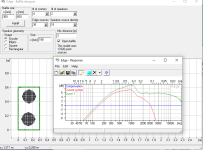
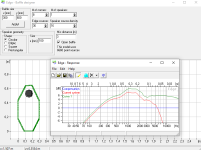
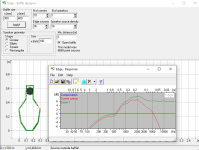
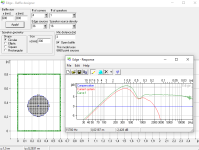
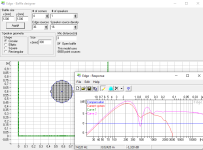
Concept of sound wavelength is crucial! Notice the logarithmic scale!

In upper range pathlength determines "axial nulling" when radiation is almost omni with less axial spl (dip in graph) and above it normal directivity of the driver and baffle edge interferences make axial and off-axis response irregular.
Simulations give an idea of what will happen - the designer has to consider driver choice, baffle dimensions and crossover freq and type. It is advisable to make a single test speaker first and measure and test how it behaves. Free air and in-room will always be different! Cheap leftover mdf or plywood plates are ok for this. And since you have a bunch of drivers, learn to do measurements and start testing!
Below some simple Edge sims. Move mouse above the pic to see driver size in inches and baffle in mm. Each pic shows on-axis response and off-axis at roughly 30deg.
Edge uses ideal drivers with flat membrane and flat response, in anechoic environment.





Concept of sound wavelength is crucial! Notice the logarithmic scale!
Last edited:
- Home
- Loudspeakers
- Multi-Way
- OB + IB = Good?